
Background information
Behind the scenes of Switzerland’s most renowned Asian mushroom producer
by Darina Schweizer

Swapping my succulents for shiitake, I’ve turned my living room into a breeding ground for mushrooms. Read on to find out how that happened and why a trip to the mountains worked unexpected wonders.
Recently, I felt like I’d died and gone to mushroom heaven. In the underground cold storage rooms at Kernser Edelpilze GmbH, I got the chance to see hundreds of shiitake, nameko, shimeji, pleurotus, enoki and king oyster mushrooms springing up from the ground.
The shapes, colours and aromas were so intoxicating to me that I decided there and then to start growing shiitake mushrooms in my living room.
Buoyed up by the experience, I take a «mushroom factory» (website in German) home with me in a handy cardboard box and place it in the middle of my living room. The only problem is that my rooftop apartment is still hitting 28.8 degrees at the beginning of September. Twice as hot as in the cold storage room in Kerns.
That means there’s only one thing springing up out of that substrate – mould. Sure, I know that’s a fungus too. But it’s not the one I’m after.
Fortunately, Kernser Edelpilze GmbH took pity on me. At the beginning of November, the company sent me a new substrate containing mycelium. The fibre mesh consists of fungal cells comparable to the root system of plants. This is what the mushrooms will grow out of. Since my first attempt, the mushroom-growing conditions in my apartment have improved. Granted, it’s not the optimal 14-degree temperature of the cold storage rooms in Kerns, but it’s around the 20-degree mark. Let the growth begin!
I start off by opening up the cardboard box. The rectangular substrate block made of wood, recycled grain waste and plant fibres, mycelium, water and gypsum is still wrapped in cling film. It’ll stay that way until the first shiitake break through and hit the plastic.
A day later, the big moment has arrived. I can practically hear the shiitake screaming, «Let us out!» I cut open the plastic, take out the substrate block and pop it on the cardboard base provided. From this point on, I’ll have to spritz the mushrooms with a water sprayer every morning and evening.
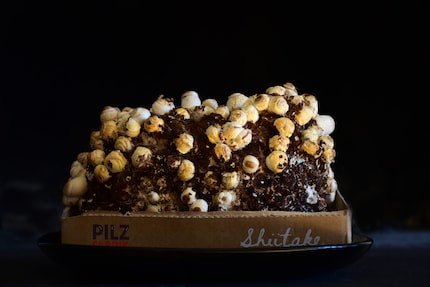
The shiitake don’t look particularly mushroomy yet. They’re more like plump, little warts. That being said, mushroom caps are beginning to shape up on a few of them. Just have a look at this one:
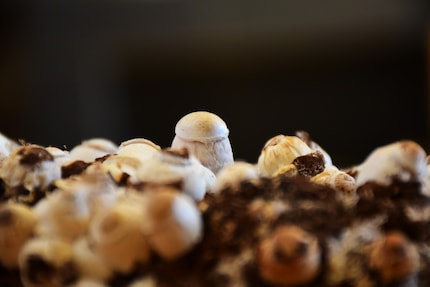
The growths gradually turn into wonderful-smelling mini mushrooms with clearly recognisable caps. Cute little guys.
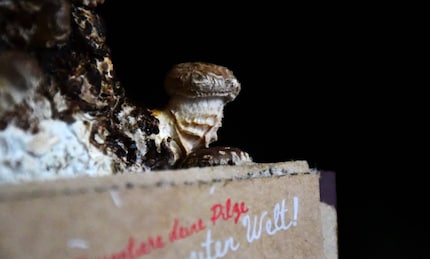
Time for a field trip. This weekend, I’ve been invited to a birthday party at a mountain hut. Leave the shiitake at home, you say? Impossible! If they miss their twice-daily water sprays, they’ll dry out. My only option is bringing them to Engelberg with me. And the cool mountain air seems to do them good. Small, white dots form on the mushroom caps – their typical distinguishing feature. In China, this has earned shiitake the nickname of «winter mushroom».
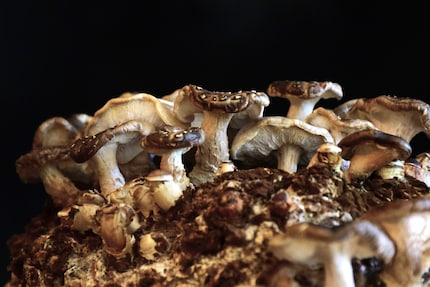
Back in the lowlands, the mushrooms are sprouting like crazy. A number of them have already opened their lamellae. Time for me to get my shiitake together.
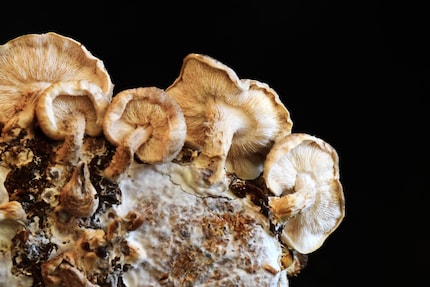
I carefully sever the mushrooms from their roots, cutting half a centimetre below the cap. If you think this is best done with a knife, think again. After some unnecessary faffing around, I eventually grab a pair of scissors. Moments later, I’ve got a harvest of 51 mushrooms. Tipped onto the kitchen scales, the whole lot comes to a weight of 52 grammes.
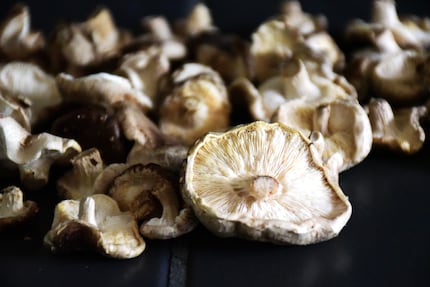
I shove them in a paper bag and put them in the vegetable drawer in the fridge. Apparently shiitake last a week if you store them like this...
So much for a week. With my belly already rumbling, I toss the shiitake into a pan on that very same day along with some butter, onions, leek, flour, vegetable stock, cream, salt, pepper and spaghetti. Will it be any good or will I have to resort to cooking dried shiitake from the Galaxus range?
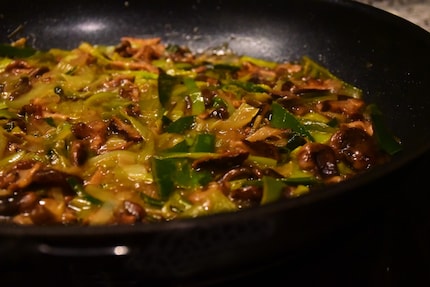
Turns out I don’t need a back-up plan. My mushroom spaghetti tastes deliciously umami. And it certainly doesn’t need any Aromat.
Growing shiitake mushrooms at home is great fun. And it’s easier than I’d expected. At 19 francs, the mushroom factory is fairly pricey – especially if you compare it to a 3-5-franc pack you’d get from a wholesaler. And a supermarket pack of mushrooms is about double the weight of my measly 52-gramme harvest. Despite this, I’d recommend the mushroom factory as a fun experiment. And with a bit of luck, my shiitake might grow back. To do this, I’ll have to immerse the substrate block in cold water and then spray it with water again twice a day. Let’s hope it works.
Ever tried your hand at cultivating mushrooms? Did you take things a step further and make the substrate yourself? Tell me all about it in the comments.
I like anything that has four legs or roots. The books I enjoy let me peer into the abyss of the human psyche. Unlike those wretched mountains that are forever blocking the view – especially of the sea. Lighthouses are a great place for getting some fresh air too, you know?